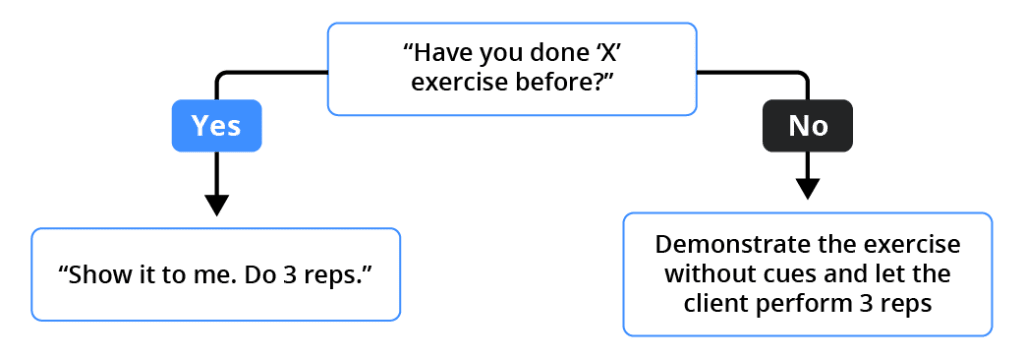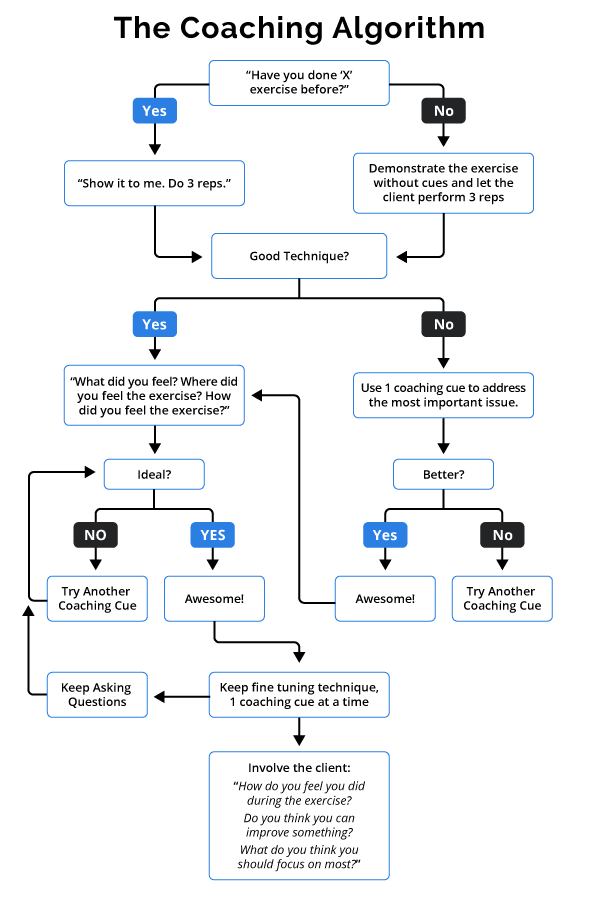Your job is to help your clients meet their fitness goals. It’s that simple and it’s that hard. Coaching is the foundational skill that allows this to happen. Without the coach, the fitness program design and exercises are just the disjointed components of an incomplete tool shed.
Much in the same way we have program design philosophies and systems for proper strength programming, we should also have a framework for coaching. I’m not talking about the different types of cues, like “stand tall and proud,” to use. I’m referring to a mental framework of sorts that every trainer can follow to coach properly and effectively.
This coaching framework is simple. Called the “coaching algorithm,” it is based on two very simple premises:
- Talk less
- Ask questions
They sound so simple, but many personal trainers still don’t know how to properly apply them. If you follow this algorithm, you will know how and when to deliver the appropriate cues during a workout routine to be able to guide your clients from having inadequate technique to being able to perform exercises as safely as possible.
Onward.
1. Talk less to make the client think less
During my Cressey Sports Performance internship, one of the things I learned from fellow coach Miguel Aragoncillo is to talk less and use fewer words while coaching. Taking three minutes to explain a single cue or cueing excessively can overwhelm the client; not to mention it takes more of your time to teach an exercise.
Be concrete and precise.
Otherwise, excessive cueing can make the client pay too much attention to the coordination of their movements, which can interfere with learning and disrupt performance, as Gabriele Wulf pointed out in her book Attention and Motor Skill Learning.
Let’s say you’re about to start the training session with a brand new workout program for a brand new client. First exercise on the list: trap bar deadlift.
A normal personal trainer might go straight to demonstrating the exercise and saying something like:
“You’re going to grab the bar, have your back straight, toes pointing forward, knees slightly bent and eyes looking forward and down; then you’re going to push the floor away, squeeze glutes at the top...”
If I were the client, I’d have lost you at something about keeping my back straight. Remember, this client is brand new to exercise and probably feels uncomfortable!
Instead, the coaching algorithm starts with a question:

If the client is already familiar with an exercise, he may be able to perform it well and correctly without the need of any cueing. If he doesn’t know the exercise, I prefer to demonstrate it without any cueing and just say, “Try to do what I just did and show me three reps.”
Sometimes clients will do the exercise with good form without any additional explanation. Overly analytical clients might ask you to tell them where to put their arms, hips, or feet. If this happens, just say: “Don’t think about it, just try it.”
If the client doesn’t perform the exercise with good technique, start with a single cue that focuses on the most important issue. Also, aim for good technique, not perfect technique. Nobody gets an exercise perfectly on their first try, so don’t try to correct everything at once. For example, if the client is flexing his back during a deadlift, it’s probably not a good idea to cue him to make a double chin, adjust his feet position, or do both.
Focus on one, but remember we want to do it with less talking. In this example for coaching a neutral spine, we can use Miguel’s “Do this, not this” technique. Here’s how it would work.
- You say, “You’re doing this” and you show a flexed low back. “We don’t want this,” you tell the client.
- You say, “We want this” and demonstrate a neutral spine.
- Say, “Show me the wrong way” and make sure the client shows a flexed back.
- Say, “Show me the right way” and have the client show a neutral spine.
- Say, “Do it a couple of times” and make sure the client moves from flexed to neutral spine position a couple of times.
- Ask, “Do you feel the difference?” and the client would nod.
See how it works? You break everything down into easy-to-understand pieces and reinforce it in the client at every step. Simple, yet effective.
We want our clients to think less and do more. As Dan John wrote:
2. Ask questions: Move from directing to asking
Proper technique and execution are more than how an exercise looks; how it feels is just as important.
A client can perform a good-looking deadlift, but when you ask her where she feels the exercise her response can be “in the low back.” If she’s never done the exercise before and you hadn’t asked how it felt, she might think that feeling a deadlift in the low back is normal.
This is why I always like to ask the following questions when the client finishes her lift:
- “What did you feel?”
- “Where did you feel the exercise?”
- “How did the exercise feel?”
The answers to these can often give you clues about areas that need improvement. If the client tells you that she feels a hip thrust in her quads, you probably have to try some cueing strategies to fire up her glutes. In this example, you can use: “push the floor away through your heels”, “lift the toes off the ground when pushing”, or “think of crushing nuts between your butt cheeks.”
Questioning can also serve not just as a means of gathering information to coach better, but as a way of coaching.
Let me explain.
Once you’ve spent some time coaching a client who already has a grasp of what good technique looks and feels like, we can shift our coaching style from directing to questioning. Instead of always cueing and telling them what to focus on, we can start asking them for their insight on how they’re performing. Questions such as:
- “How do you think you did during the exercise?”
- “Do you think you can improve something?”
- “What do you think you should focus on most?”
Many times the client has a good idea of what to focus on. Doing this not only involves them in the process, but also increases their self-efficacy.
The picture below is a diagram of how the coaching algorithm should go:










